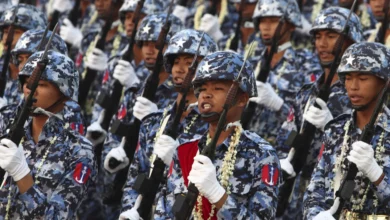
(CNN)UN Secretary-General António Guterres announced a plan Wednesday to ensure every single person on the planet has access to early warning systems for extreme weather and climate disasters within the next five years.
Early warning systems inform people that dangerous weather is on the way. They have been crucial in saving lives in extreme weather events, such as tropical cyclones, flooding, storms, forest fires and tornadoes, and can help communities — particularly those that rely on farming — to adapt to upcoming changes in weather.
Yet a third of the world’s population is not covered by these systems. And where they have been absent, hundreds, even thousands, of lives have been lost in single extreme weather events.
The climate crises is expected to make many of these events more intense and frequent.
“Human-caused climate disruption is now damaging every region,” said Guterres in a video message. “Half of humanity is already in the danger zone.”
He added, “We must boost the power of prediction for everyone and build their capacity to act.”
The UN’s World Meteorological Organization (WMO) will spearhead the effort in an attempt to save not only lives but billions of dollars, by giving communities a heads up that a weather or climate-related threat is imminent.
While a lot of climate focus has been on reducing greenhouse gas emissions, there is a growing understanding that humans need to invest more into adapting to the crisis. A recent report by the Intergovernmental Panel on Climate Change found that some ecosystems — and humans — are reaching tipping points where adapting to the new climate and conditions may become impossible if global warming isn’t reined in.
“We must invest equally in adaptation and resilience. That includes the information that allows us to anticipate storms, heatwaves, floods and droughts,” Guterres said.
Inadequate warnings
While a third of the world lives without these crucial warning systems, in Africa, the number jumps to 60%.
That’s had devastating consequences. The WMO pointed to Tropical Cyclone Idai, which hit Mozambique, Malawi and Zimbabwe in 2019, as an example of inadequate warnings, communication and education — which Guterres said was “unacceptable, particularly with climate impacts sure to get even worse.”
“The meteorological services of Malawi and Zimbabwe were not able to forecast the event at all,” said Petteri Taalas, the Secretary-General of the WMO, in an email to CNN.
“In Mozambique the storm surge, wind speeds and rainfall amounts were forecasted by the national meteorological service, but the responsible authorities were not acting to prevent human and economic losses since they didn’t fully understand the risks caused by Idai.”
There were more than 1,300 deaths from Idai, UN figures show.
Over the past 50 years (1970-2019), a weather, climate or water-related disaster has occurred on average almost every day, killing 115 people a day with a cost of $202 million every day, according to a 2021 WMO report on disaster statistics.
The WMO report also points out that “the number of recorded disasters increased by a factor of five over that 50-year period, driven by human-induced climate change, more extreme weather events and improved reporting.”
However, because of better warning systems in place, the number of lives lost has decreased by nearly three-fold.
In the case of Typhoon Haiyan, which hit the Philippines in 2013 and killed 6,000 people, warnings didn’t reach those who needed them most, and when they did, many people didn’t understand them, the WMO told CNN.
A WMO analysis of the typhoon’s impact found people failed to evacuate because they underestimated the danger.
The research team concluded that there needed to be a more “integrated multi-hazard approach to warnings” and evacuation centers need to not be in areas that are at risk of flooding.
Giving a community a warning of just 24 hours ahead of a coming storm or heat wave can cut damage by 30%, according to the Global Commission on Adaptation.
“Spending $800 million on such systems in developing countries would avoid losses of $3-16 billion per year,” the report also said. That savings would be up to 20 times the initial investment.
Some warnings come too late
In some cases, warnings are issued, but not soon enough for people to take action.
The most recent example would be the flash flooding and landslides in Brazil in February.
“Brazil’s National Meteorological Service had indeed warned of very heavy rainfall, but people were not prepared,” the WMO told CNN. Flash floods happen extremely quickly and are difficult to predict, and are also exacerbated by land use, building practices and a lack of urban planning, according to the WMO.
The WMO said it was continuing to fight for better weather warnings, and putting educational programs in place.
“Even though the number of disasters has increased and economic costs are rising, the death toll has fallen dramatically,” a spokesperson for the WMO said. “Horrific death tolls of hundreds of thousands of people 50 years ago in Bangladesh and Myanmar are now history.”
Guterres has tasked the WMO to present an action plan at the next UN climate conference in Egypt this November.




